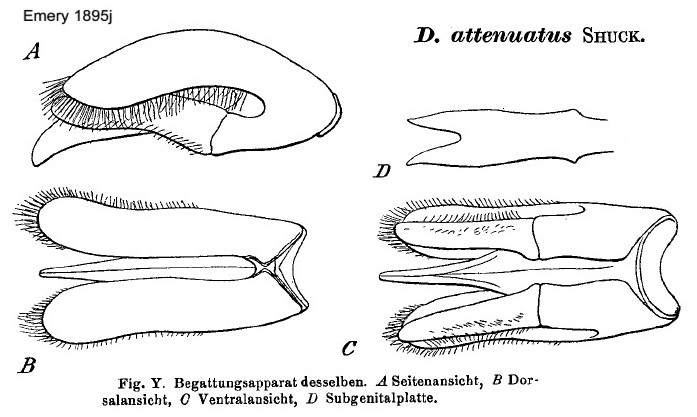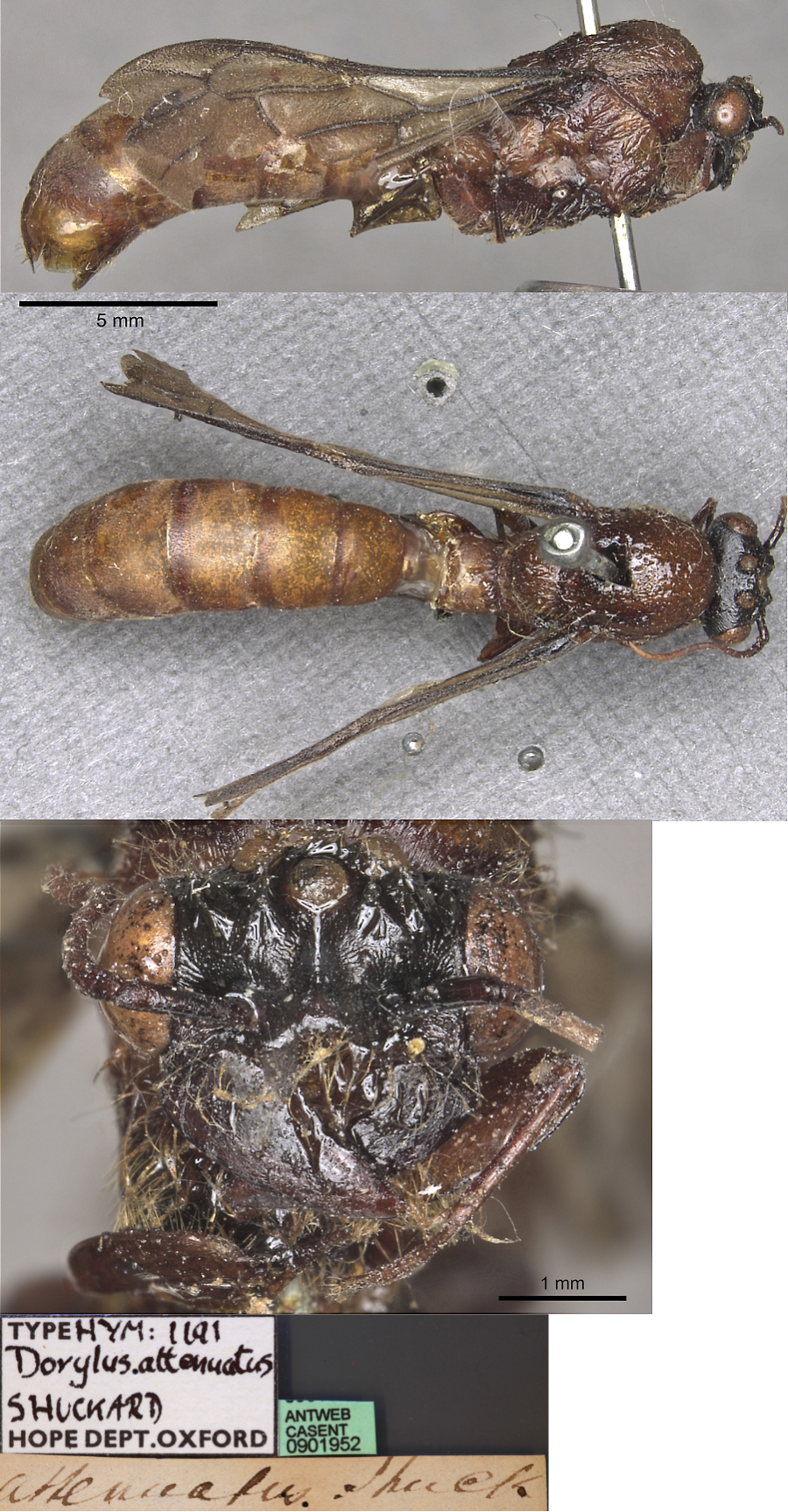Dorylus (Alaopone) attenuatus Shuckard
 Males - Males -   Type locality Gambia?
(Dorylus attenuatus, Shuckard,
1840c: 322, male) - see below Type locality Gambia?
(Dorylus attenuatus, Shuckard,
1840c: 322, male) - see below
subspecies
acuminatus (Dorylus
(Alaopone) attenuatus var. acuminata
n. var., Emery, 1899e: 462, male) from South Africa, Orange
Free State - see below
australis (Dorylus (Alaopone) montanum
Sants. stirps australis n. st., Santschi, 1919b: 231, worker;
placed under attenuatus by Santschi, 1939a: 147, without
any obvious reasons) from South Africa, Cape Province,
Herschell District, G Arnold - see below
bondroiti (Dorylus (Alaopone) montanus
Sants. var. Bondroiti n.
var., Santschi, 1912b: 162, male) from South Africa, Transvaal,
from Bondroit - see below
latinodis (Dorylus
(Alaopone) attenuatus Shuck. race. latinodis, Forel, 1920: 479, male)
from Zaïre - no images on Antweb (June 2014)
junior synonym umbratipennis (Dorylus
(Alaopone) attenuatus Shuck. v. lumbratipennis n. var., Forel,
1909b: 52,
male) from Zaïre - no images on Antweb (June 2014)
male only known (see Bolton, 1995)  . .
|
 Shuckard's (1840c) description is at Shuckard's (1840c) description is at  - he noted "I am not sure of the locality
of this species, but I believe it is from the Gambia". Arnold (1915)
provided a transcript of Shuckard's description, plus acuminata
- this is at - he noted "I am not sure of the locality
of this species, but I believe it is from the Gambia". Arnold (1915)
provided a transcript of Shuckard's description, plus acuminata
- this is at  . Emery (1895j) provided
a translation into German of Shuckard (1840c), and added illustrations
of the genitalia - this is at . Emery (1895j) provided
a translation into German of Shuckard (1840c), and added illustrations
of the genitalia - this is at  , and Emery's (1899e) description of the acuminata
male is at , and Emery's (1899e) description of the acuminata
male is at  . Santschi's (1912b)
description of the male of bondroiti is at . Santschi's (1912b)
description of the male of bondroiti is at  . Santschi's (1919b) description of the
worker of australis
is at . Santschi's (1919b) description of the
worker of australis
is at  .
Forel's (1920) description of the
male of latinodis is at .
Forel's (1920) description of the
male of latinodis is at  . .
|
 TL 21.7 mm; anterior wing 17 mm; seen from
above the extremity of the stipe is rounded and divergent; wings dull
(obscure), slightly yellowish, with reddish brown nerves; pale reddish;
head black, mandibles and scape pitch; gaster dull; (Santschi, 1912b). TL 21.7 mm; anterior wing 17 mm; seen from
above the extremity of the stipe is rounded and divergent; wings dull
(obscure), slightly yellowish, with reddish brown nerves; pale reddish;
head black, mandibles and scape pitch; gaster dull; (Santschi, 1912b).
Forel (1909b) noted that the male umbratipennis,
a single specimen collected by Tosquinet, from "Nini?" [probably
actually Vivi]; differed from the type in having brown wings; in the
type they are subhyaline and slightly yellowish.
|
 The
photomontage is of the holotype male collated from http://www.antweb.org/specimen.do?name=casent0901952.
The state of the specimen makes it difficult to be sure but it seems
likely that the two forms, bondroiti
and acuminata, from South
Africa are synonymous but are different to the type attenuata. The head of attenuata clearly is black as stated by Shuckard, the other two are reddish-brown. Assuming the Antweb scales are correct, the type attenuata is notably smaller than the others. The
photomontage is of the holotype male collated from http://www.antweb.org/specimen.do?name=casent0901952.
The state of the specimen makes it difficult to be sure but it seems
likely that the two forms, bondroiti
and acuminata, from South
Africa are synonymous but are different to the type attenuata. The head of attenuata clearly is black as stated by Shuckard, the other two are reddish-brown. Assuming the Antweb scales are correct, the type attenuata is notably smaller than the others.
|